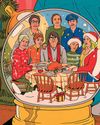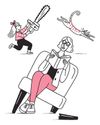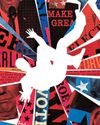
Three winters in a row, Kate DiCamillo went into the hospital, never sure if she would come home and always a little scared to do so. One of those winters, when she was four years old and the air outside was even colder than the metal frames of the oxygen tents she'd grown accustomed to having above her bed, her father came to see her. He was wearing a long black overcoat, which made him look like a magician. "I brought you a gift," he said, pulling something from his pocket as if from a top hat.
DiCamillo studied the red net bag in her father's hands, then watched as a set of wooden figurines tumbled out of it: a farmer, his wife, a cow, a pig, a chicken, a barn, a sun, and a moon. All the pieces were roughly the same size-the pig as big as the barn, the sun as small as the cow. Her father began arranging them on the hospital sheet, which was white and crisp as paper. He told her a story about them, then asked if she could tell him one in return. She did, and, for the first time in a long time, she was not afraid of him.
That was half a century ago, but, DiCamillo told me recently, she feels as if she's never really stopped moving those pieces around. She has written more than thirty books for young readers, and is one of just a handful of writers who have won the Newbery Medal twice. Novels such as "Because of Winn-Dixie," "Flora & Ulysses," "Raymie Nightingale," "The Beatryce Prophecy," and "The Tale of Despereaux" have endeared her to generations of children who see themselves in her work-sometimes because her human characters are shy or like to sing or have single parents as they do, but more often because their yearnings, loneliness, ambivalence, and worries are so fully, albeit fantastically, captured in the lives of her magical menagerie: a chivalrous little mouse, a poetry-writing squirrel, a "not-so-chicken chicken," and more than one rescue dog.
Esta historia es de la edición September 18, 2023 de The New Yorker.
Comience su prueba gratuita de Magzter GOLD de 7 días para acceder a miles de historias premium seleccionadas y a más de 9,000 revistas y periódicos.
Ya eres suscriptor ? Conectar
Esta historia es de la edición September 18, 2023 de The New Yorker.
Comience su prueba gratuita de Magzter GOLD de 7 días para acceder a miles de historias premium seleccionadas y a más de 9,000 revistas y periódicos.
Ya eres suscriptor? Conectar

YULE RULES
“Christmas Eve in Miller’s Point.”

COLLISION COURSE
In Devika Rege’ first novel, India enters a troubling new era.

NEW CHAPTER
Is the twentieth-century novel a genre unto itself?

STUCK ON YOU
Pain and pleasure at a tattoo convention.

HEAVY SNOW HAN KANG
Kyungha-ya. That was the entirety of Inseon’s message: my name.

REPRISE
Reckoning with Donald Trump's return to power.

WHAT'S YOUR PARENTING-FAILURE STYLE?
Whether you’re horrifying your teen with nauseating sex-ed analogies or watching TikToks while your toddler eats a bagel from the subway floor, face it: you’re flailing in the vast chasm of your child’s relentless needs.

COLOR INSTINCT
Jadé Fadojutimi, a British painter, sees the world through a prism.

THE FAMILY PLAN
The pro-life movement’ new playbook.

President for Sale - A survey of today's political ads.
On a mid-October Sunday not long ago sun high, wind cool-I was in Harrisburg, Pennsylvania, for a book festival, and I took a stroll. There were few people on the streets-like the population of a lot of capital cities, Harrisburg's swells on weekdays with lawyers and lobbyists and legislative staffers, and dwindles on the weekends. But, on the façades of small businesses and in the doorways of private homes, I could see evidence of political activity. Across from the sparkling Susquehanna River, there was a row of Democratic lawn signs: Malcolm Kenyatta for auditor general, Bob Casey for U.S. Senate, and, most important, in white letters atop a periwinkle not unlike that of the sky, Kamala Harris for President.